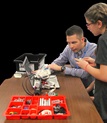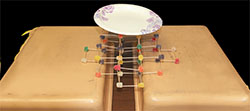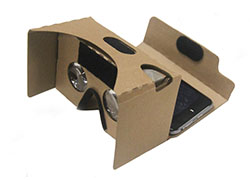 Geoff Bizan is a K–6 STEM enrichment teacher and Lake George EA member. A National Board Certified Teacher and Teacher Leadership Coach for Technology Integration with the Greater Capital Region Teacher Center, Bizan uses a mix of "old-school" and "new-school" tools to get kids excited about Science, Technology, Engineering and Math. The best part? These activities are so much fun, they don't feel like "school" at all.
Geoff Bizan is a K–6 STEM enrichment teacher and Lake George EA member. A National Board Certified Teacher and Teacher Leadership Coach for Technology Integration with the Greater Capital Region Teacher Center, Bizan uses a mix of "old-school" and "new-school" tools to get kids excited about Science, Technology, Engineering and Math. The best part? These activities are so much fun, they don't feel like "school" at all.
Here are a few of his favorites that might work in your classroom or for an after-school program:
 Lego Mindstorms EV3
Lego Mindstorms EV3
Students (fifth grade and up) can create and command rob o t s that walk, talk and do anything they are programmed to do. This tool is a great way to teach STEM, including robotics and coding. Ultrasonic sensors measure distance to the nearest inch or centimeter. Students can work in pairs or small groups. The kit includes plenty of curriculum resources.
 Sphero SPRK Edition
Sphero SPRK Edition
A playful robot that makes programming fun! Using a tablet or iOS device, students can command the robot to jump, change color or make a figure like an isosceles triangle. Free lessons and apps for educators are available through the SPRK community.
 Pro-Bot
Pro-Bot
This programmable robot creates great opportunities to integrate math concepts, such as geometry, into coding. Pro-Bot has an onboard display where students can program the car to turn at a certain degree. The robot can leave a trail by attaching a marker. Students can use math concepts and programming concepts to create drawings. For example, with grades three and up, Bizan would ask students to program the bot to draw the letter "A."
Marshmallows
The "marshmallow challenge" encourages teamwork, engineering and thinking outside the box. Students have 18 minutes to use one marshmallow, 20 pieces of spaghetti, a yard of tape and a yard of string to build a structure where the marshmallow is on top. The trick is to keep testing designs — younger students tend to be more successful. (Older students tend to plow ahead and wait until the end to test). This is one project where first-graders can out-perform sixth-graders, Bizan said.
 Sweets and cents
Sweets and cents
Bizan's third-graders work on a "Gumdrop Bridge" project, using 50 gumdrops, 100 toothpicks, a ruler and pencil and paper. The engineering project requires students to work in teams to design a bridge that will clear a six-inch gap (between desks) and be strong enough to hold a paper plate with the weight of 300 pennies.
 Google cardboard box
Google cardboard box
Put a smartphone in this $10 box and use a Google app to create a virtual reality field trip to anywhere from a rain forest to the Eiffel Tower. Google Cardboard uses Google Street View to create a virtual reality experience at a low cost.
Web-based tools
Scratch is an activity Web page that allows students to create interactive stories, games and animations through a visual programming language. A variety of free resources are available for teachers to utilize this tool in the classroom. Check out scratch.mit.edu.
Hopscotch for iOS is an app that enables the user to create video games easily by dragging blocks of code with your fingertip. The app has lessons for students and teachers.
Nearpod is a free Web-based or app-based tool that engages students with fun and interactive content; collects and shares student responses; and tracks student understanding in real time. Visit near pod.com.
Bizan suggests checking with your local teacher center about robotics courses and borrowing equipment. For example, he teaches a "Coding tools for the K–8 classroom" course with the Greater Capital Region Teacher Center, which offers a loan program for the Sphero and Pro-Bot.
My cool tools
showcases the variety of tools NYSUT members use to make their jobs and projects sparkle.